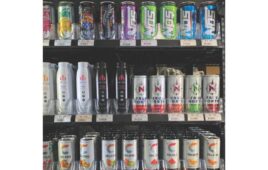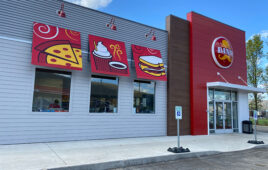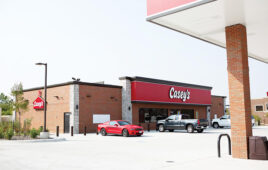 The events of the past few years have pushed convenience stores to rethink traditional category management strategies. Once steady, reliable product families were shaken by the drastic changes ushered in by the COVID-19 pandemic. When in-store traffic dropped off early on, many categories suffered the consequences, except for gift cards. Throughout the past three years, gift cards have been a consistent performer for the convenience store industry.
The events of the past few years have pushed convenience stores to rethink traditional category management strategies. Once steady, reliable product families were shaken by the drastic changes ushered in by the COVID-19 pandemic. When in-store traffic dropped off early on, many categories suffered the consequences, except for gift cards. Throughout the past three years, gift cards have been a consistent performer for the convenience store industry.
Why has this product segment performed so well while other c-store staples were significantly impacted? Simply put, the gift card category has three factors that have helped immunize it from an unsteady pandemic economy. First, the sector enjoyed notable upticks prior to COVID, which provided a firm foundation.
Already a perennial favorite to mark occasions, especially holidays, graduations and birthdays, people continued to celebrate special days with gift cards throughout the pandemic.
During the end-of-year holiday season last year, combined sales of physical and digital gift cards saw double-digit increases, according to Blackhawk Network’s “2021 Post-Holiday Shopping” study.
Forecasts for the upcoming holiday season have yet to be released; however, industry watchers are optimistic, especially after reports for the first half of 2022 show gains.
“The use of gift cards as a whole continues to grow, and savvy retailers are finding new use cases, such as charitable giving and employee incentives, to get the most out of gift cards at their businesses,” said Tom Niedbalski, vice president of gift solutions for Fiserv, which provides financial technology services to clients across the financial services sector.
For Kwik Trip Inc., the La Crosse, Wis.-based family-owned company that runs more than 800 stores in the Midwest, sales of gift cards in 2022 have outpaced the previous two years.
“Over the first nine periods of our fiscal year, gift cards sold at the stores have increased 42% in 2022 versus the first nine periods of our fiscal 2021. Our online/Scrip gift card sales are running 23% higher in fiscal 2022 compared to fiscal 2021 and 35% higher than the first nine periods of fiscal 2020,” said David Wagner, controller for Kwik Trip.
Through the Scrip program, non-profit organizations purchase cards at a discount to resell them for fundraising purposes at a higher price with the proceeds going to the organization.
“The discount is typically 5%, but we offer higher discounts at certain times of the year,” said Wagner. “We believe this is a great way to help the non-profit organizations in the communities we serve, while at the same time driving additional guest traffic to our stores.”
Plus, employers are purchasing c-store branded cards to reward employees. Again, this trend bodes well for convenience stores because such programs occur year-round and, according to Blackhawk Network, nearly half of recipients expect to spend more than the card’s value.
Convenient Giving
Another factor keeping the gift card category resilient is convenience. Cards are easy for the giver and offer recipients a freedom to shop for items they truly desire. Now, another convenience has emerged.
“In recent months, with inflation tightening purse strings for many consumers, we have also seen growing demand for store-branded gift cards for retail locations where consumers make everyday purchases, such as big box stores, grocery stores and c-stores/gas stations,” said Niedbalski.
While this has been a well-grounded practice for open-loop cards that can be reloaded with funds, as measured by sales quantity, they far trail behind closed-loop options.
“According to our recent consumer research, only 20% of consumers will purchase an open-loop prepaid card when giving a gift, with the other 80% turning to store-branded cards,” said Niedbalski.
If inflation continues, individuals may regard gift cards as a convenient way to support family and friends. Additionally, the Retail Gift Card Association (RGCA) stated cards are being used for government-funded and non-profit assistance programs and are a preferred system for the un- or under-banked.
“Since gift cards are both popular for gifting and serve as versatile payment tools, physical and digital cards are both in high demand, and we expect consumers to continue using both depending on their personal preferences,” said Kim Sobasky, a RGCA spokeswoman.
Financial Flexibility
The third factor buoying the category is that consumers value the option of either physical or digital forms and the fact that funds from both can be transferred to mobile wallets. However, it appears people enjoy having the card in hand.
“While digital commerce is on the rise globally, physical gift cards are still more preferred than digital cards, according to Fiserv’s ‘19th Annual Prepaid Consumer Insights Survey.’ This is in line with recent industry research indicating that market share for digital prepaid cards has stabilized in recent years, holding around 38%,” said Niedbalski.
But new types of currency also have convenience store owners weighing how to smartly and cost-effectively incorporate more variety in financial products offered to customers.
Retailers have long featured debit machines at store locations. Some sites offer check cashing or bill paying services, which can be critical for individuals who find themselves un- and under-banked.
Could cryptocurrency in c-stores be the next stage?
It is for Kwik Trip. By next month, the chain hopes to roll out bitcoin ATMs. Only time will tell if the public will view such access as another convenience and motivation to visit c-stores.




